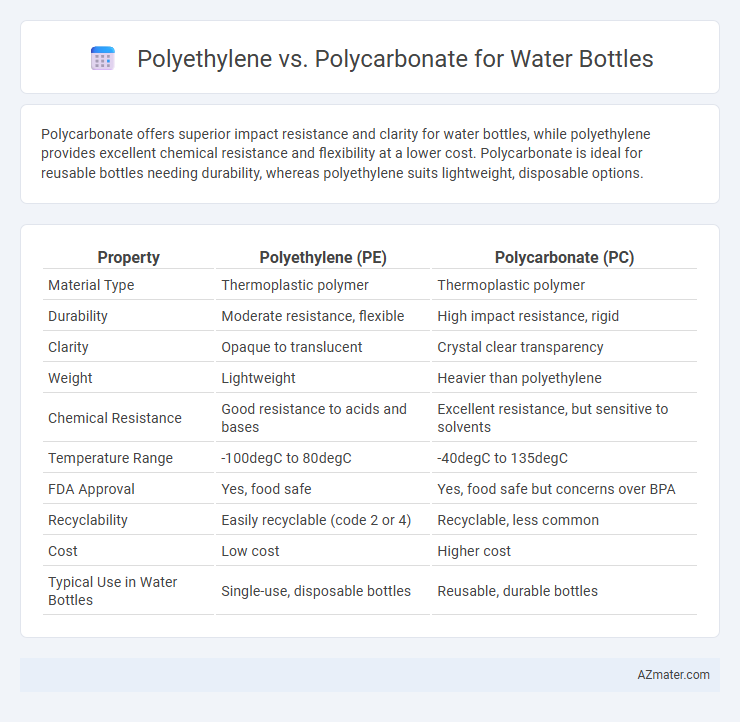Polycarbonate offers superior impact resistance and clarity for water bottles, while polyethylene provides excellent chemical resistance and flexibility at a lower cost. Polycarbonate is ideal for reusable bottles needing durability, whereas polyethylene suits lightweight, disposable options.
Table of Comparison
| Property | Polyethylene (PE) | Polycarbonate (PC) |
|---|---|---|
| Material Type | Thermoplastic polymer | Thermoplastic polymer |
| Durability | Moderate resistance, flexible | High impact resistance, rigid |
| Clarity | Opaque to translucent | Crystal clear transparency |
| Weight | Lightweight | Heavier than polyethylene |
| Chemical Resistance | Good resistance to acids and bases | Excellent resistance, but sensitive to solvents |
| Temperature Range | -100degC to 80degC | -40degC to 135degC |
| FDA Approval | Yes, food safe | Yes, food safe but concerns over BPA |
| Recyclability | Easily recyclable (code 2 or 4) | Recyclable, less common |
| Cost | Low cost | Higher cost |
| Typical Use in Water Bottles | Single-use, disposable bottles | Reusable, durable bottles |
Introduction to Polyethylene and Polycarbonate
Polyethylene is a lightweight, flexible thermoplastic commonly used for water bottles due to its chemical resistance and affordability. Polycarbonate is a durable, transparent plastic known for high impact resistance and clarity, often chosen for reusable water bottles that require toughness and visual appeal. Both materials offer distinct benefits in terms of safety, durability, and cost for water bottle manufacturing.
Material Composition and Properties
Polyethylene water bottles are made from long chains of ethylene monomers, known for their lightweight, flexibility, and high chemical resistance, making them ideal for everyday use. Polycarbonate bottles consist of bisphenol A (BPA) derived polymers, offering exceptional impact resistance, clarity, and heat tolerance, suitable for reusable and durable containers. Polyethylene excels in low-cost production and safety for cold liquids, while polycarbonate provides superior strength and transparency but requires careful consideration of BPA content.
Durability and Strength Comparison
Polycarbonate water bottles exhibit superior impact resistance and tensile strength, making them ideal for heavy-duty use and long-term durability. Polyethylene bottles, while more flexible and less prone to cracking, have lower tensile strength and are more susceptible to deformation under stress. Selecting polycarbonate ensures enhanced structural integrity, whereas polyethylene offers lightweight durability with moderate strength.
Safety and Health Considerations
Polycarbonate water bottles often contain BPA, a chemical linked to potential hormonal disruptions, raising safety concerns for prolonged use. Polyethylene, especially high-density variants (HDPE), is BPA-free and considered safer for food and beverage storage due to its inert properties. Health-conscious consumers typically prefer polyethylene bottles to minimize exposure to harmful chemicals and ensure better safety during hydration.
Taste and Odor Retention
Polycarbonate water bottles typically offer superior taste and odor retention compared to polyethylene, as their denser molecular structure prevents flavor transfer and minimizes the absorption of external odors. Polyethylene, especially low-density variations, can sometimes retain residual plastic tastes and absorb odors over time, affecting the water's purity. For users highly sensitive to taste and odor, polycarbonate materials often provide a cleaner, more neutral drinking experience.
Weight and Portability
Polyethylene water bottles are significantly lighter, making them ideal for portability and everyday carry. Polycarbonate bottles offer greater durability but come with increased weight, which may reduce convenience during extended outdoor activities. Choosing polyethylene enhances lightweight portability without compromising basic functionality.
Transparency and Aesthetics
Polycarbonate offers superior transparency and optical clarity compared to polyethylene, making it ideal for water bottles that showcase the liquid inside. Polycarbonate's glass-like appearance enhances aesthetics with a smooth, polished finish, while polyethylene tends to be more opaque and less visually appealing. The choice between the two materials depends on the desired balance between visual appeal and durability, as polyethylene offers better chemical resistance and flexibility.
Environmental Impact and Recyclability
Polyethylene water bottles offer high recyclability and lower environmental impact due to their simpler polymer structure, enabling efficient processing in recycling facilities and reducing plastic waste accumulation. Polycarbonate bottles, while durable and heat-resistant, present recycling challenges because of bisphenol A (BPA) content and complex polymer matrices, which limit recycling options and raise concerns over chemical leaching and environmental toxicity. Choosing polyethylene supports a more sustainable lifecycle with better resource recovery and reduced ecological footprint compared to polycarbonate alternatives.
Cost and Availability
Polyethylene water bottles are generally more affordable due to lower raw material costs and simpler manufacturing processes, making them widely available in various markets. Polycarbonate bottles, while more costly, offer superior durability and clarity but are less common and typically found in specialty or premium product lines. Availability of polyethylene products dominates both retail and wholesale segments, whereas polycarbonate options are limited and often sourced from specialized suppliers.
Choosing the Best Material for Your Water Bottle
Polyethylene offers lightweight durability and excellent chemical resistance, making it ideal for casual, everyday water bottles, particularly those meant for cold liquids. Polycarbonate is renowned for its high impact resistance and clarity, suitable for reusable water bottles that require toughness and a stylish appearance, but may release BPA unless treatment or alternatives are used. Choosing the best material depends on priorities such as safety, weight, durability, and intended use, with polyethylene favored for affordability and safety, and polycarbonate preferred for toughness and transparency.

Infographic: Polyethylene vs Polycarbonate for Water Bottle
 azmater.com
azmater.com